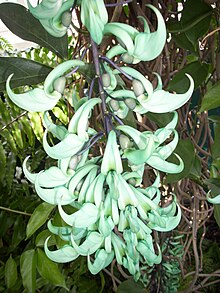Strongylodon macrobotrys
| Strongylodon macrobotrys | |
|---|---|
 |
|
| Jade vine flowers at The Enid A. Haupt Conservatory at the New York Botanical Garden | |
| Scientific classification | |
| Kingdom: | Plantae |
| (unranked): | Angiosperms |
| (unranked): | Eudicots |
| (unranked): | Rosids |
| Order: | Fabales |
| Family: | Fabaceae |
| Genus: | Strongylodon |
| Species: | S. macrobotrys |
| Binomial name | |
|
Strongylodon macrobotrys A.Gray |
|
| Synonyms | |
|
|
Strongylodon macrobotrys, commonly known as jade vine, emerald vine or turquoise jade vine, is a species of leguminous perennial liana (woody vine), a native of the tropical forests of the Philippines, with stems that can reach up to 18 m in length. Its local name is "tayabak". A member of the Fabaceae (the pea and bean family), it is closely related to beans such as kidney bean and runner bean.Strongylodon macrobotrys is pollinated by birds and bats.
The pale green foliage consists of three leaflets. The claw-shaped flowers are carried in pendent trusses or pseudoracemes of 75 or more flowers and can reach as much as 3 m long. The turquoise flower color is similar to some forms of the minerals turquoise and jade, varying from blue-green to mint green. The short, oblong, fleshy seedpods are up to 15 cm long and contain up to 12 seeds.
The plant grows beside streams in damp forests, or in ravines. The inflorescences are only produced by mature vines. Each individual bloom resembles a stout-bodied butterfly with folded wings; they have evolved certain modifications to allow them to be pollinated by a species of bat that hangs upside down on the inflorescence to drink its nectar. The flowers are also visited by a species of wasp, and are home to a species of butterflies.
There are several other species of Strongylodon, but the superficially similar red jade vine, Mucuna bennettii, is a species belonging to a different genus, Mucuna. It seems to be endemic to the Philippines and is usually found in forests.Propagation has always been difficult. It is considered an endangered species due to the destruction of its habitat and the decrease of its natural pollinators. There seems to be a method of marcotting through mature woody stems. It is best planted in ground near a water source, but not inundated. The vine entwines itself through the trunk and branches of trees and the leaves spread over the canopy. The flowers hang like clusters of grapes.
...
Wikipedia
